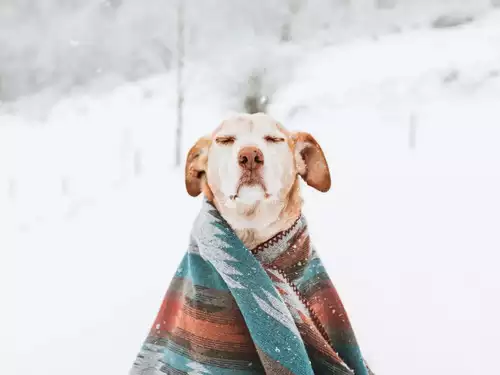Just like humans, furry pets also need some extra tender love and care when the chilly seasons come around. This blog will provide you with some tips.

The time between December to February is excruciatingly cold, not only for the humans but for their furry pets too. Therefore, it is the responsibility of the pet parents to think about their pets’ safety and comfort in the cold months. This blog will explore some of the precautionary tips that you can use to make your pet feel the most comfortable this winter. But first, you need to understand what humans feel as cold might not be same for the animals.
When you are thinking of how cold is too cold for a dog, temperatures that are below 0°C are definitely very cold for dogs in winter. Therefore, you should ensure that you don’t allow your dog outside for long periods. Just like humans, very young dogs and senior dogs are more susceptible to cold winters. A thick coat may protect your dog but their ears, nose, tail, and paws are still more exposed than the rest of its body. If you find symptoms like lethargy, watery eyes and nose, sneezing, shivering, or general weakness in your pet, then it can be a sign of your dog feeling cold. At such times, if your dog has an outdoor kennel, it is crucial to bring them inside. You should also be sure to change your dog’s drinking water every now and then to provide them with water that is of the right temperature.
In steel bowls, water tends to run cold very soon when exposed to the open air. You can check the body temperature of dogs to ensure that they are under the normal range. This will give you a clear idea of whether your dog is cold or comfortable. You can also give them healthy hard chew bars, to keep them nibbling and chewing, which will ensure that they don’t just go cold without any activity. These hard bars will let your dogs exercise their jaws, which can be a great source of calcium for their teeth and other essential proteins and vitamins.
- Avoid long walks; instead play indoor games to warm up their bodies: Dogs in winter do need their exercise on a daily basis; however, it is best to be a little cautious during this season. Especially early in the morning or late at night when the temperatures are at their lowest, it is advisable to stick to shorter walks and indulge in more indoor playtime. This will ensure that they get their daily dose of exercise and fun while keeping the cold winters at bay. Though the average body temperature of dogs is around (38.3 to 39.2°C) which is higher than that of a human, it still is imperative to keep your dog protected from harsh weather conditions.
- A warm spot for wintry nights: Many dog owners think that their pooch is fine without extra blankets during the winter because it has fur, but veterinarians advise giving your dog warm clothes or keeping them warm by spreading a blanket. You can also add extra layers of a fluffy blanket underneath them to provide that extra coziness. Most often, if the temperature is a tad too cold for you, it’s likely to be the same for your pets too.
- Buy a Doggie Jacket: Some breeds that have lush coats may be able to handle cold weather better than breeds that are smaller and with shorter fur. You can get your pooch a jacket or sweater to wear when you’re outdoors together. Buy a jacket that fits snugly and that isn’t too tight. You should also make sure that it doesn’t have zippers or any metallic attachments that can cause irritation or pose a choking hazard. If your dog doesn’t warm up to the idea of wearing the jacket, you can keep them outdoors for a shorter period of time during the day and let him spend more time indoors at other times.
- Don’t Shave the Fur: Dogs are blessed with thick fur, which naturally keeps them warm. So, avoid shaving it off completely in winter. Besides, never take your pet dog out for a walk right after bathing it. Depending on the region’s temperature, bathe them with lukewarm or warm water. Let them dry off indoors and do not let them step out with the wet coat. Also, remember their natural coat will not prevent frostbite on the feet, tail, or ears. Hence, do not keep your dog out in the freezing temperature for too long.
- Warm Bedding: Never let your dog sleep on the floor, especially during the winter season. Prolonged contact with the cold floor may lead to falling sick. Choosing the right bedding is important to ensure that your pet dog stays warm. There are various mattresses for pets available in the market. Buy one for your four-legged friend and enjoy watching them snuggling on it. You may also place the mattress in a warm spot preferably a carpet area.
- Keep Them Away from the Room Heater: If you have a dog that moves around frequently in the house, do away with the heating source such as room heaters, etc. Dogs often seek heat during a cold season by snuggling close to any of the heating sources. There are chances that the pet dog may get close to any radiator object and get a burn. Avoid space heaters and have a pet-proof system to keep your pet away from any harm.
- Keep Them Hydrated: Just like humans, animals too are thirstier in the winter season. Keep a check as the water in their drinking bowl may get colder and they may not drink water from it. So, it is suggested to replace the old water with room-temperature water every 2-3 hours.
- Do Not Overfeed: The pet needs an extra layer in the winter season, ensure that it comes from a warm coat and not a layer of fat. Increase the pet’s supply of food, give high-quality food, but do not overfeed. Cold temperatures may bring on lazy behavior. So, be mindful of your pet’s activity and accordingly adjust the diet.
- Don’t Miss the Health Checkup: Your pet may be prone to arthritis and have a tough time in the cold weather. So, pay a little more attention to their daily routine and exercises. It’s better to consult the veterinary and have in place the medications or health supplements if required.
- Paw care is Imperative: Just like humans, dogs too develop cracked pads. Ensure that you trim the hair of your furry friend to prevent ice buildup between the pads. Trimming is important for overall hygiene. After walks around the neighborhood or park either rinse or wipe the paws to remove any water salt. Also, prevent flaky or dry skin by applying coconut oil on the skin of the pet. If the pet’s ears or tail appear dry, you may consider applying oil as needed.
- Be prepared:Winter can bring blizzards and power outages. Prepare an emergency kit and include your pet in your plans. Have enough food, water, and medicine (including any prescription medications as well as heartworm and flea/tick preventives) on hand to get through at least five days.
- Avoid walking on frozen water: Stay away from frozen ponds, lakes, and other water. You don’t know if the ice will support your pet’s weight and falling through the ice could be deadly.
Just like humans dogs and other furry pets are also susceptible to various illnesses during the winter season. One additional tip that you can apply is to keep some household medicines near in case they catch a cold. Homeopathy medicines work the best and have no side effects. This kind of medicine is appropriate for both humans and pets. But unlike the humans the pets are not able to take care of themselves, they rely solely on their hoomans for their comfort and safety. When you become a pet parent, you become aware that you have taken on the responsibility of taking care of a baby, may not be a human one but they are still just like babies who need constant care and affection. You should keep these handy winter tips in mind for your pet and enjoy the breezy season without missing out on the fun things of the chilly season but do not forget to give them winter cuddles as it is an ideal way to keep them warm.


















